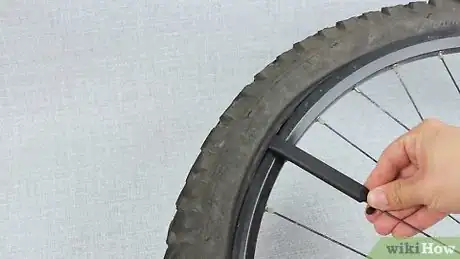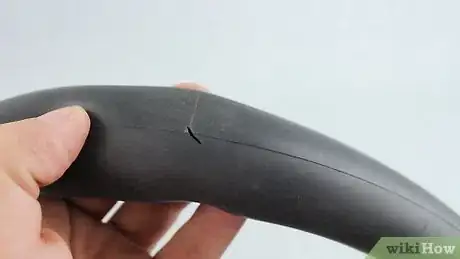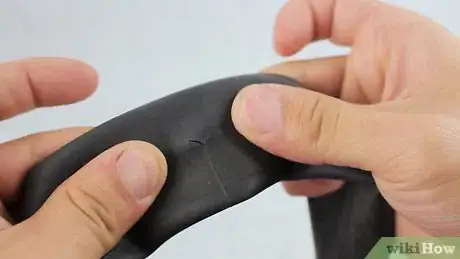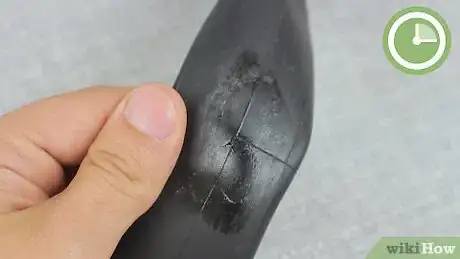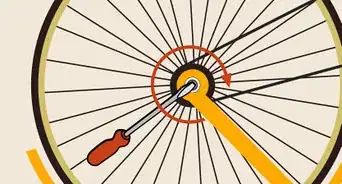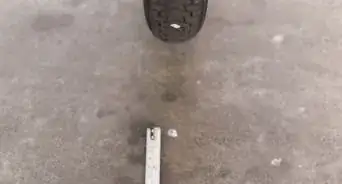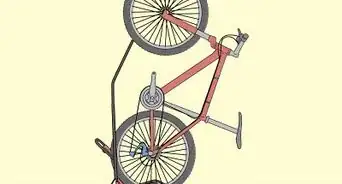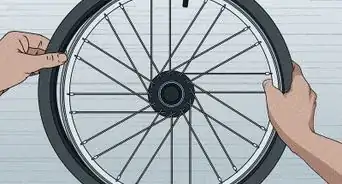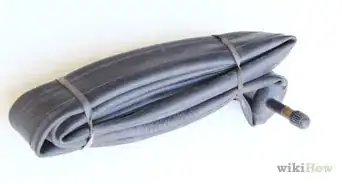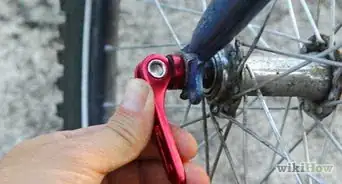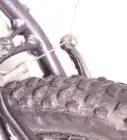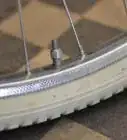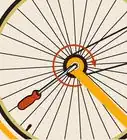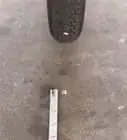This article was co-authored by Jonas Jackel. Jonas Jackel is the Owner of Huckleberry Bicycles, a bicycle retail store based in San Francisco, California. Jonas has over 20 years of experience managing bicycle retail stores and has operated Huckleberry Bicycles since 2011. Huckleberry Bicycles specializes in servicing, repairing, and custom building road, cross, gravel, touring, folding, and e-bikes. Jonas was also previously sat on the Board of Directors for Bike East Bay, a bicycle-advocacy non-profit organization based in Oakland, California.
There are 8 references cited in this article, which can be found at the bottom of the page.
This article has been viewed 52,698 times.
All kinds of things can puncture your bicycle tire when you’re out on a ride. A puncture hole is an inconvenience, but fortunately, it’s easy to fix with the right tools and tricks. First, remove the tire and locate the hole in the tube. Use a patch kit to glue a patch onto the hole. Inflate the tube to check your work, then reattach the tire to the wheel. You’ll be back riding in no time.
Steps
Finding the Puncture
-
1Take the tire and tube off the wheel. Remove the wheel by unfastening the handle holding the axle in place. Then, use a tire lever to get the tire off. Insert the lever between the tire and the rim and work it around. When the tire comes off, pull the tube out.[1]
- It may be easier to remove the tube if you let all of the air out.
-
2Remove the object that punctured the tire if it’s still there. If the object is still there, it could re-puncture the tube when you replace it, wasting all your work. Sometimes finding the object is easy, like if a nail is sticking out of the tire. Other times, glass or small rocks get trapped inside the tire, so shake the tire out to get rid of any loose objects.[2]
- Gently run your fingers along the inside of the tire to free any embedded objects. If you have gloves, put them on to protect your fingers from cuts.
- Check the surface of the tube as well.
Advertisement -
3Pump up the tube and look for the hole. Finding the hole is difficult if the tube is deflated. Hook a pump to the tube and fill it with air. Then do a visual check for the hole. If the hole is large, it should be easy to see. Check along the entire surface of the tube for obvious holes.[3]
- Don’t stop looking when you find the first hole. If an object got inside the tire, it could leave multiple holes, so be sure to check the entire tube.
-
4Listen for air escaping if you can’t see the hole. If the hole is too small to see with a visual check, bring the tube up to your ear. Give it a light squeeze to force the air out, and listen for a “seeping” sound to hear where it escapes from. Then, use these signs to locate the hole.[4]
- You still might not be able to pinpoint the hole, even if you hear the seeping sound. Use the water method to find its exact location.
-
5Dunk the tube into a filled sink to see where bubbles come up from. If you still can’t find the hole, fill a sink with water and place the tube inside. Squeeze it so air escapes, and then check where bubbles rise up from. When you see the bubbles, you have an exact location for the hole.[5]
- This trick is useful if you know roughly where the hole is but can’t pinpoint it. The bubbles give you an exact location.
- This won’t be possible if you get a flat tire while out biking, so try your best to listen for escaping air in that case.
-
6Mark the hole so you don’t lose it. If you're dealing with a small hole, it can be hard to see, so making a mark on the tube will make it easier to find the area you need to repair again. Some patch kits come with a piece of chalk, so use this and draw a circle around the hole. Otherwise, use a marker.[6]
- Don’t use a pen or pencil. These could make another hole in the tube.
Patching the Hole
-
1Sand the rubber around the hole to help the glue adhere. Most patch kits come with a small piece of sandpaper to rough up the rubber and provide more surface area for the glue to bond to. Take the sandpaper and lightly rub it around the hole. Stop when the rubber changes color slightly.[7]
- If your patch kit doesn’t come with sandpaper, then use a coarse-grain sandpaper around 100-grit.
-
2Apply patching glue with your finger. Squeeze a dab of patching glue on your finger and rub it around the hole. Apply a section that’s roughly the same size as the patch you’re using.[8]
- Don’t use too much glue or the tube could stick to the inside of the tire when you put them both back on the wheel.
- The glue rubs off of skin when it dries. If it doesn’t come off, wash your hands with soap and warm water.
-
3Let the glue sit for 30-60 seconds. Once the glue hits the air, it gets tacky and stickier. It reaches its peak stickiness after about a minute, so let the glue sit for that amount of time before placing the patch down. Otherwise it won’t stick as well.[9]
-
4Press the patch onto the hole. Remove the foil on the back of the patch like a sticker. Align the patch so its center is directly over the hole, then press it down. Hold the patch for 1 minute so it adheres to the glue.[10]
- Be careful not to get the back of the patch dirty. Any dirt or debris will prevent a tight seal.
-
5Inflate the tube to make sure the seal is tight. Connect the tube to the pump and re-inflate it. Listen around the patch for any air escaping. If you don’t hear any seeping sounds, then the seal is tight enough.[11]
- For another test, submerge the tube in a full sink and check if you see any air bubbles. If not, then the seal is tight.
-
6Place the tube and tire back onto the wheel. First, tuck the tube into the tire. Then check the tire for any arrows indicating which direction it should be installed in. Insert the valve plug straight through the hole on the wheel. Work around the wheel and press the tire into the beads on the wheel. Then put the wheel back on the bike.[12]
- Check to make sure no parts of the tube are sticking out from under the tire. If it is, use a tire elver to push it back in.
- Make sure the valve plug points straight out of the tire. If it’s crooked, it could get damaged.
References
- ↑ https://www.cyclingweekly.com/news/product-news/fix-a-puncture-142674
- ↑ https://www.cyclingweekly.com/news/product-news/fix-a-puncture-142674
- ↑ https://youtu.be/Q2sKMqB9QCg?t=71
- ↑ https://youtu.be/Q2sKMqB9QCg?t=71
- ↑ https://youtu.be/Q2sKMqB9QCg?t=92
- ↑ https://www.theguardian.com/lifeandstyle/2016/may/03/cycling-how-to-fix-a-puncture-even-if-you-dont-have-the-right-tools
- ↑ https://youtu.be/Q2sKMqB9QCg?t=143
- ↑ https://roadcyclinguk.com/how-to/maintenance/beginners-guide-how-to-repair-a-punctured-road-bike-inner-tube.html
- ↑ https://roadcyclinguk.com/how-to/maintenance/beginners-guide-how-to-repair-a-punctured-road-bike-inner-tube.html
Community Q&A
-
QuestionCan you buy a new wheel?
 Gabriel GalarzaCommunity AnswerYes, you can; it's also the only solution when the puncture is too big, in or near another patch, or when the tire has many punctures, or has been fixed lots of times.
Gabriel GalarzaCommunity AnswerYes, you can; it's also the only solution when the puncture is too big, in or near another patch, or when the tire has many punctures, or has been fixed lots of times.
Things You'll Need
- Tire patch kit
- Tire lever
- Coarse sandpaper
Warnings
- Always start riding slowly after doing any bike repairs. This will catch any problems, like the tire being installed incorrectly.⧼thumbs_response⧽
